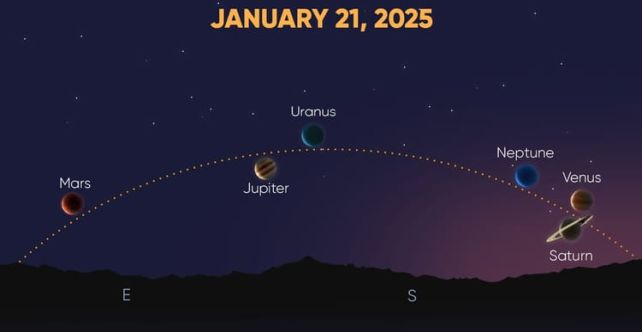A very rare treat is about to grace Earth's night skies.On the evening of 28 February 2025, all seven of the other planets in the Solar System will appear in the night sky at the same time, with Saturn, Mercury, Neptune, Venus, Uranus, Jupiter, and Mars all lining up in a neat row – a magnificent sky feast for the eyes known as a great planetary alignment.But that's not all. Between now and then, on 21 January 2025, six of the seven other planets will appear in the sky at once in a large alignment – Mars, Jupiter, Uranus, Neptune, Venus, and Saturn, with the exception of Mercury.

An illustration of the upcoming January planetary alignment as seen from the Northern Hemisphere. (Star Walk)
Actually, it's not uncommon for a few planets to be on the same side of the Sun at the same time, but it's less common for most, or even all of the planets to align.Any number of planets from three to eight constitutes an alignment. Five or six planets assembling is known as a large alignment, with five-planet alignments significantly more frequent than six.Seven-planet great alignments are, of course, the rarest of all. READ MORE...
Nuclear fusion propulsion technology has the potential to revolutionize space travel in terms of both speeds and fuel usage. The same kinds of reactions that power the Sun could halve travel times to Mars, or make a journey to Saturn and its moons take just two years rather than eight.
It's incredibly exciting, but not everyone is convinced this is going to work: the tech needs ultra-high temperatures and pressures to function.
To help prove the viability of the technology, the largest ever fusion rocket engine is now being built by Pulsar Fusion in Bletchley, in the UK.
The chamber, some 8 meters (26 feet) long, is scheduled to start firing in 2027.
As you might expect, replicating the Sun inside a rocket isn't easy. At the center of nuclear fusion propulsion is an ultra-hot plasma locked inside an electromagnetic field, and scientists are continuing to figure out how to do this in a stable and safe way.
"The difficulty is learning how to hold and confine the super-hot plasma within an electromagnetic field," says James Lambert, CFO of Pulsar Fusion. "The plasma behaves like a weather system in terms of being incredibly hard to predict using conventional techniques." READ MORE...
Scientists propose a lost moon of Saturn, which they call Chrysalis, pulled on the planet until it ripped apart, forming rings and contributing to Saturn’s tilt. This natural color view of Saturn was created by combining six images captured by NASA’s Cassini spacecraft on May 6, 2012. It features Saturn’s huge moon Titan, which is larger than the planet Mercury. Below Titan are the shadows cast by Saturn’s rings. Credit: NASA/JPL-Caltech/Space Science InstituteAccording to a new study, a “grazing encounter” may have smashed the moon to bits to form Saturn’s rings.Swirling around the planet’s equator, the rings of Saturn are an obvious indicator that the planet is spinning at a tilt. The belted gas giant rotates at a 26.7-degree angle relative to the plane in which it orbits the sun. Because Saturn’s tilt precesses, like a spinning top, at nearly the same rate as the orbit of its neighbor Neptune, astronomers have long suspected that this tilt comes from gravitational interactions with Neptune.However, a new modeling study by astronomers at MIT and elsewhere has found that, while the two planets may have once been in sync, Saturn has since escaped Neptune’s pull. What was responsible for this planetary realignment? The research team has one meticulously tested hypothesis: a missing moon. Their study was published in the journal Science on September 15. READ MORE...



